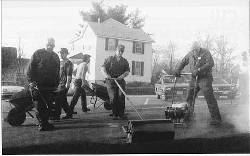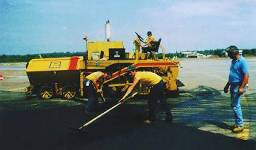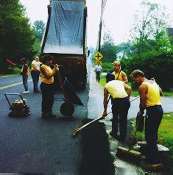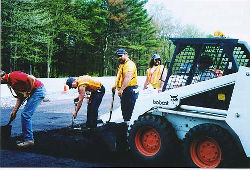
The Finishing Touches By John S. Ball III
 Handwork should not be overlooked when finishing a project.
Handwork should not be overlooked when finishing a project.
Whether your crew is putting the finishing touches on a mainline highway paving project, or building a homeowner's driveway from the bottom up, an appreciation for handwork is critical. In some ways a lost art, handwork can make or break your crew's reputation. Machine work is usually the most visible aspect of hot mix asphalt paving, because it is in machine work that contractors have the largest volume of work. But handwork perfects what is achieved by a machine, and that is what makes handwork so important. It can be learned, but requires talent. And, although everyone can do handwork, some crew members make a specialty of certain tools. From the roller operator to the laborer, crew members make a name for themselves with the talent they apply to the use of different tools.
The most common hand tools used in HMA paving are the lute, rake, shovel, broom, hand compactor or tamper, hand roller, straight edge, and wheelbarrow. Tamper shoes, mauls, and a ball of string are also used in handwork.
Segregation occurs often in handwork because, in the process, hot mix material is being moved often. The more the mix is moved, the more chance there is for larger pieces of stone in the hot mix to rise to the top of the surface, while fines float to the bottom. That's one reason it is important to master the use of a particular tool, and master it quickly. In many cases, if the person isn't comfortable using a particular implement, another crew member will take over the work.
Hot mix is dumped from the wheelbarrow, the pile is raked, it's luted, and finally compacted. The work moves from left to right, down the road. Once the raker reaches the opposite edge of the road, like a typewriter platen, he returns to the beginning edge, and starts the process again. All the while, the luter, compactor operator, and other workers follow suit.
The tools of the trade
 The tools of the trade The best type of rake to use in handwork is a steel one because it [Image] makes moving hot mix that much easier. With a good, strong steel rake, the raker can push a pile forward, then quickly pull it out. The result is a level mix, free from segregation, and ready for the next step - luting.
The tools of the trade The best type of rake to use in handwork is a steel one because it [Image] makes moving hot mix that much easier. With a good, strong steel rake, the raker can push a pile forward, then quickly pull it out. The result is a level mix, free from segregation, and ready for the next step - luting.
The lute is a 7 foot (2.3 meter) long pole, at the end of which is attached a 36 inch (900 mm) Iong by 3 inch (75mm) high blade. The blade is smooth on one side and serrated on the other. It is long so that the lute person can reach out to the mix with the smooth end, and barely touch the material as it glides along the paved surface. The serrated edge of the lute can be used to cure any imperfections left behind by the raker. The  material left in to cure any imperfections left behind by the raker. The material left in [Image] place by the luter must be the correct depth all the way across the pavement.
material left in to cure any imperfections left behind by the raker. The material left in [Image] place by the luter must be the correct depth all the way across the pavement.
The hand roller and maul are used often in conjunction with tamper shoes, especially if work is being done close to a building. The wide tamping shoes, which force the crew member to walk like a duck, are immersed in a release agent or solvent before the walking and tamping pattern begins. In place of tamper shoes, crew members will often attach maul pads, dipped in a release agent, onto their own workboots. 
Mauling is an art. The maul has a base 8 inches (200 mm) long by 6 [Image] inches (150 mm) wide, and is designed with a 4 foot (1.33 meter) high wooden handle held straight up at 12 o'clock. Another handle juts out at 3 o'clock, and the tamping is done in an up and down motion, much like churning butter. To seal driveways or pavement joints, the maul sometimes is tipped 45 degrees to create an angle for compaction. A hand compactor, often weighing 400 to 500 lbs. (I80 to 225 kilograms), is equipped with a water tank. As the operator walks behind the heavy machine, water disperses from the compactor to prevent it from picking up asphalt particles. The operator moves the machine forward and back across the pavement to compact the material. It can be used to finish a small job, or as an intermediate step before a I ton (I metric ton) roller is used in a larger paving project.
The ball of string is used as a string line, to judge whether the edge of the pavement is straight or not. Any excess material is cut from the edge to produce a straight product. In road widening work, the string line will be layed out by two people, tightening and loosening the  string to achieve the layed out by two people, tightening and loosening the string to achieve the [Image]perfect position. They will then apply a paint gun to mark a radius or other spot. These tools are the basics for handwork. Others are used in more specialized work, such as in asphalt curbing, in which asphalt is fed into the curb machine with a wheelbarrow or by hand shovel. Also, as the curb is layed out, and the crew arrives at the corners, a hand trowel is the specialty tool often used to keep the asphalt material together.
string to achieve the layed out by two people, tightening and loosening the string to achieve the [Image]perfect position. They will then apply a paint gun to mark a radius or other spot. These tools are the basics for handwork. Others are used in more specialized work, such as in asphalt curbing, in which asphalt is fed into the curb machine with a wheelbarrow or by hand shovel. Also, as the curb is layed out, and the crew arrives at the corners, a hand trowel is the specialty tool often used to keep the asphalt material together.
Often overlooked, handwork can make or break a project, especially if it involves commercial work. The public is demanding when it comes to the look of pavements, especially when that pavement is John Q. Public's driveway. Contractors working in the private sector have found a lucrative niche, one that can only survive if the pavement looks perfect. Raking and luting are the first and last steps to any paving project, and are like artwork. Done properly, handwork is worth its weight in gold.
Home | Articles | Qualification | Calculators
Top Quality Paving
PO Box 4398
Manchester, New Hampshire 03108
Cell Phone 603-493-1458
Write to us at our E-mail address for more information
tqpaving@yahoo.com
Visit Asphalt Contractor Magazine Online!
WebMaster: Sullivan+Wolf Design, LLC
 The tools of the trade The best type of rake to use in handwork is a steel one because it [Image] makes moving hot mix that much easier. With a good, strong steel rake, the raker can push a pile forward, then quickly pull it out. The result is a level mix, free from segregation, and ready for the next step - luting.
The tools of the trade The best type of rake to use in handwork is a steel one because it [Image] makes moving hot mix that much easier. With a good, strong steel rake, the raker can push a pile forward, then quickly pull it out. The result is a level mix, free from segregation, and ready for the next step - luting. 
 Handwork should not be overlooked when finishing a project.
Handwork should not be overlooked when finishing a project.
 material left in to cure any imperfections left behind by the raker. The material left in [Image] place by the luter must be the correct depth all the way across the pavement.
material left in to cure any imperfections left behind by the raker. The material left in [Image] place by the luter must be the correct depth all the way across the pavement. 
 string to achieve the layed out by two people, tightening and loosening the string to achieve the [Image]perfect position. They will then apply a paint gun to mark a radius or other spot. These tools are the basics for handwork. Others are used in more specialized work, such as in asphalt curbing, in which asphalt is fed into the curb machine with a wheelbarrow or by hand shovel. Also, as the curb is layed out, and the crew arrives at the corners, a hand trowel is the specialty tool often used to keep the asphalt material together.
string to achieve the layed out by two people, tightening and loosening the string to achieve the [Image]perfect position. They will then apply a paint gun to mark a radius or other spot. These tools are the basics for handwork. Others are used in more specialized work, such as in asphalt curbing, in which asphalt is fed into the curb machine with a wheelbarrow or by hand shovel. Also, as the curb is layed out, and the crew arrives at the corners, a hand trowel is the specialty tool often used to keep the asphalt material together.